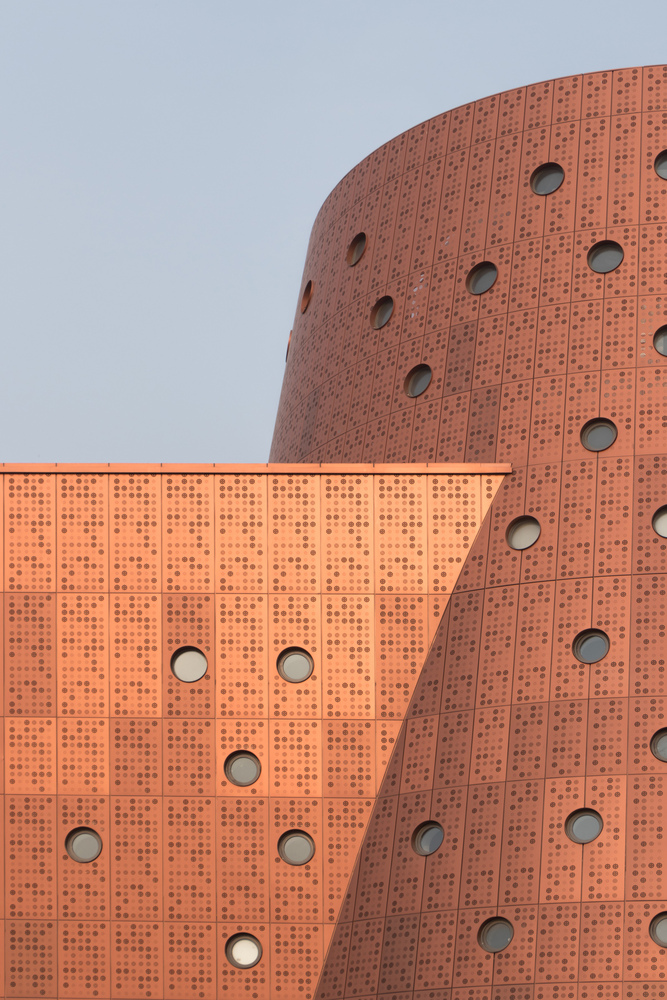SXSW Features Parametric Vault Designed by OTA+ and UT Students
2014-03-25 01:00
由一个中央悬链拱顶,钻石蜂窝结构支持两个悬臂和第三个层叠拱顶,构成展示展览内容的基础。更多的信息,从设计团队,在休息后.
Grounded by a central catenary vault, the diamond-celled structure supports two cantilevering arms and a third cascading vault that forms a base for showcasing exhibition content. More information from the design team, after the break...
© Casey Dunn
凯西·邓恩


来自设计团队:该项目开始于比格设计建造工作室的学生之间的竞争。简要地是设计一个结构使用聚集,编织和堆叠技术,以创造一个可以从图形到平面过渡到体积外壳的装配。学生们还被要求考虑皮肤竞赛的目标,将金属作为主要材料,数字制造作为建造方法。最后,选定了一个组合项目,并将其合并和完善为最后的项目-CARET 6。
From the Design Team: The project began with a competition between students in Bieg’s design-build studio. The brief was to design a structure using aggregation, weaving and stacking techniques to create an assembly that could transition from graphic to flat surface to volumetric enclosure. The students were also asked to consider the objectives of the SKIN Competition by incorporating metal as the primary material and digital fabrication as the construction method. Ultimately, a combination of projects were selected, combined and refined into the final project, Caret 6.
为了使从一个平面,二维地面顺利过渡到一个体积,三维拱顶,工作室使用的钻石模式,可以作为一个集料和编织肋骨系统。虽然钻石图案似乎是一系列堆叠的细胞,但结构实际上是三层重叠肋骨。从拱顶到拱顶的接缝是由大的、连续的主肋构成的,而第二肋骨则在每个缝之间跨越。三级肋骨完成网络,并包围每一个细胞,以创造一个刚性的结构。
To enable a smooth transition from a flat, two-dimensional ground surface into a volumetric, three-dimensional vault, the studio used a diamond pattern that could work as both an aggregate and woven rib-system. Though the diamond pattern appears to be series of stacked cells, the structure is actually three layers of overlapping ribs. Large, continuous primary ribs form the seams from vault to vault, while secondary ribs span between each seam. Tertiary ribs complete the web and enclose each cell to create a rigid structure.
工作室的一个核心目标是将不对称引入到本来是对称的形式中。拱顶的最高点大约是11‘-0“,它的空间很小,可以让居住者直接与地面接触,这对于大多数通常是更大、更高空间的拱顶来说是一个典型的情况。卡莱塔6的设计是为了填补一个已经存在的空间,因此有必要设计一个符合现有房间的几何学,特别是在边缘,在那里,拱顶形式向墙壁的投影。
A core goal of the studio was to introduce asymmetry into what would otherwise be a symmetrical form. The vault is roughly 11’-0” at its highest point, enclosing a space small enough for occupants to engage directly with the surface, a condition atypical for most vaults which often frame larger and much taller spaces. Caret 6 was designed to fill an already existing space, so it was necessary to design a geometry that responded to the existing room, especially at the edges, where the vaulting forms project toward the walls.
整个形状的不对称性通过在每个拱顶内的二次和第三肋的分布反馈到每个表面,影响了表面上的不对称钻石图案。相对于一些促进平滑分级模式应用的参数化项目,CARET 6的钻石图案从一个细胞到另一个细胞高度不同,与大得多的钻石相邻的金刚石形状小簇点状。
The asymmetry of the overall form feeds back into each surface via the distribution of secondary and tertiary ribs within each vault, influencing the asymmetrical diamond pattern on the surface. As opposed to some parametric projects that promote the application of smooth gradating patterns, the diamond pattern of Caret 6 is highly differentiated from cell to cell, pitting small clusters of diamond shapes adjacent to much larger diamonds.
© Kory Bieg
科里·比格


用目前的数字设计软件设计和分析对称拱顶是相对容易的,但一旦将非对称力引入到拱顶中,如果不是处于完美的平衡状态,就需要进行更复杂的分析和计算,以确保结构能够站得住脚。为了增加结构的挑战,安装必须是完全独立的,没有附加到地板或周围的房间。我们的工作室与得克萨斯大学工程系的教师和学生合作,以确定每一件作品的深度和厚度,并在每个柱基设计连接细节。
A symmetrical vault would have been relatively easy to design and analyze using current digital design software, but as soon as asymmetrical forces were introduced to the vault, which would otherwise be in perfect equilibrium, a more complex analysis and set of calculations were required to ensure the structure could stand. To add to the structural challenge, the installation had to be entirely free-standing, with no attachments to the floor or surrounding room. Our studio worked with faculty and students from the University of Texas Engineering Department to determine the depth and thickness of each piece and to design the connection detail at each column base.
工作室很幸运地收到了Alpolic的捐赠。Alpolic是一种铝制复合材料,通常用于覆盖大型办公楼。使用机器人结构分析,我们能够建模和测试不同的Alpolic组件,以确定一个结构合理的解决方案,仍然实现了设计的审美和形式愿望。最终,我们添加了一层附件细节,其中包括数千个O形环和粘合剂环,以确保在发生侧向力或意外点载荷时的稳定性(即。有人挂在悬臂的边缘),但在它的休息状态,卡雷特6不需要任何紧固件。
The studio was fortunate to receive a donation of Alpolic, an aluminum composite material typically used to clad large office buildings. Using Robot Structural Analysis, we were able to model and test different Alpolic assemblies to determine a structurally sound solution that still achieved the aesthetic and formal aspirations of the design. Ultimately, we added a layer of attachment details that included thousands of O-rings and binder rings to ensure stability in the event a lateral force or unexpected point load is applied (ie. someone hanging on the edge of the cantilever), but in its resting state, Caret 6 does not require any fasteners.
© Kory Bieg
科里·比格


卡莱塔6的设计是容易组装,平面包装,然后重新组装在一个新的位置.最初,该项目安装在奥斯丁大学建筑学院的Mebane画廊,作为Tex-Fab 5期间的皮肤:数字装配展览的一部分。它后来被重新安装在下一阶段和叛逆工艺博览会,作为SXSW的一部分,世界上最大的电影,互动和音乐节之一。它还将在休斯敦大学的杰拉尔德·D·海因斯建筑学院的中庭展出。
Caret 6 was designed to be easily assembled, flat-packed and then reassembled at a new location. Initially, the project was installed at the Mebane Gallery in the School of Architecture at UT Austin as part of the SKIN: Digital Assemblies Exhibition during TEX-FAB 5. It was later reinstalled at the Next Stage and Renegade Craft Fair as part of SXSW, one of the largest film, interactive, and music festivals in the world. It will also be exhibited in the atrium of the Gerald D. Hines College of Architecture at the University of Houston.
德克萨斯大学奥斯汀建筑学院OTA地点大学,德克萨斯大学奥斯汀分校,德克萨斯州奥斯汀内校园大道310号,德克萨斯州奥斯汀,78712,美国类别临时设施设计科里比格(德克萨斯大学奥斯汀建筑学院首席,OTA和助理教授)和UTSOA设计工作室V设计和制造团队阿尔蒂·哈特,亚历山大·达拉斯,亚历克西斯·穆尔,Alline Kane,Bernardo Jimenez,Brenda Morlan Villafuerte,Claire Miller,Elizabeth Fuchs,Estrella Juarez,Gabriel Tagliante,Kassiy McCarter,Kevin K亭,Layla Salameh,Michael Rahmatoulin,Nadejda Aseeva,Stancey Moore,Zachary Walters捐赠材料,三菱塑料复合材料公司。2014年项目年照片凯西·邓恩,科里·比格
Architects OTA+ Location University of Texas at Austin School of Architecture, The University of Texas at Austin, 310 Inner Campus Drive, Austin, TX 78712, United States Category Temporal Installations Design Kory Bieg (Principal, OTA+ and Assistant Professor, University of Texas at Austin School of Architecture) and UTSOA Design Studio V Design and Fabrication Team Aarti Khatter, Alexander Dallas, Alexis Meur, Alline Kane, Bernardo Jimenez, Brenda Morlan Villafuerte, Claire Miller, Elizabeth Fuchs, Estrella Juarez , Gabriel Tagliante, Kelsey McCarter, Kevin Keating, Layla Salameh, Michael Rahmatoulin, Nadejda Aseeva, Stancey Moore, Zachary Walters Material Donation Alpolic Materials, Mitsubishi Plastics Composites America, Inc. Project Year 2014 Photographs Casey Dunn, Kory Bieg




































































